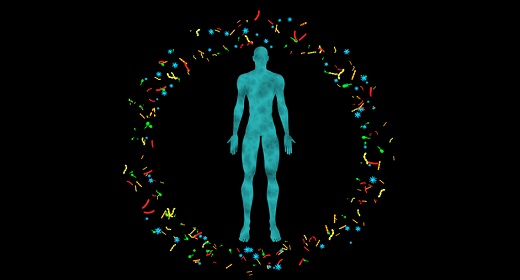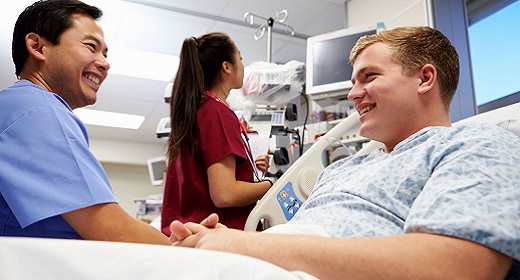by Shelly Fan: What if the solution to our health problems is already inside our bodies?
The human body is replete with billions of microbugs thriving on our skin, inside our intestines, and even our private parts. Their collective, microbiomes, are not simple passengers. Rather, their diversity, gene expression, and metabolism changes when we cross from health into disease.
Yet the million-dollar question remains: can we crack the two struggles of chronic disease—early diagnosis and treatment—by tinkering with the microbiome?
Nearly a decade ago, the National Institute of Health kicked off the Human Microbiome Project (HMP) to profile multiple microbiomes in detail. Thanks to advances in molecular and genomic tools, scientists were able to map the genes, metabolisms, and lives of our microbug inhabitants, just as we’ve been able to do with our own cells.
Yet microbugs are just half of the equation. To truly understand how they forecast or contribute to chronic disease, we also need data about the other half: us.
This month, the second phase of HMP (iHMP), released detailed datasets on how microbiomes impact diabetes, inflammatory bowel disease, and pregnancy and preterm births. The decade-long study functionally probed microbiome shifts with unprecedented breadth and depth, detracting skeptics—and guarding against hype—for the role of our bodies’ microscopic communities in our health. iHMP further gathered biomarkers and genetic analyses from 463 hosts for up to four years, dynamically painting a long-term movie of their health.
“The generation of this rich resource is a landmark achievement,” said Drs. Verónica Lloréns-Rico & Jeroen Raes at the Rega Institute for Medical Research, who were not involved in the project.
Diabetes
Led by Dr. Michael Snyder at Stanford University, the largest study in iHMP tracked 106 participants for 4 years, extensively sampling their blood and poop every 3 months, and profiled changes in their gut and nose microbiomes. Some of the volunteers were prediabetic, a condition that leads to full-blown diabetes in 70 percent of people; others were healthy. The team also profiled the volunteers’ immune systems and extensively monitored their microbiomes during respiratory infections.
Overall, the participants’ microbiomes remained relatively stable—until they got hit by the flu. Metabolically healthy people mount a widespread immune defense that coordinates with alterations in their nose and gut microbiomes. But those with prediabetes had a much more muted immune response, and also showed fewer changes in their nasal microbugs.
Unfortunately, differences between people are generally larger than differences between health and disease, which makes microbiomes difficult biomarkers for diabetes. However, the team managed to fish out several personalized “molecular signatures,” including microbiome patterns, that marked people who eventually became diabetic.
What pushes someone over the edge from prediabetes to full-on disorder is still unclear. Based on his data, Synder thinks infections may be one cause—and an easy point of intervention. The results are also meaningful for managing heart and blood vessel diseases, blood disorders, or even cancer, the project noted.
Inflammatory Bowel Disease (IBD)
IBD affects millions of people worldwide, and the numbers are increasing. The disease is also one of the first linked to microbiome changes, and why physicians consider “poop transplants” a potential way to transfer healthy microbiomes to those in need.
Dr. Curtis Huttenhower at the Broad Institute and Harvard University led a team that tracked 132 people for a year, collecting nearly 3,000 stool, biopsy, and blood specimens to generate multiple large datasets of the IBD microbiome across time.
The study found a variety of differences in the microbiome and the host’s immune response as the disease progressed—much larger than previous thought. The IBD microbiome reverts back to normal configurations when the disease isn’t active, but dramatically changes in its microbug species composition when IBD flares back up. By simultaneously profiling the host’s biomolecules, the team found a handful of immune-related chemicals that shape the microbug community in IBD patients, which could become biomarkers for the disease. IBD microbiome makeup was also far more prone to shifts than control volunteers, and the team was able to generate a score to characterize these shifts into disease using multiple metrics.
Finally, the study constructed nearly 3,000 different ways the hosts and their microbugs interact at the cellular and molecular levels during IBD—including entire species missing from IBD patients. A map like this, the authors said, hints at entirely new groups of potentially beneficial organisms for IBD, and draws out important interaction highways for intervention.
Preterm Birth
The third branch of iHMP, led by Dr. Gregory Buck at Virginia Commonwealth University, zoomed in on women’s health, examining characteristics of the vaginal microbiome that potentially increase the risk of preterm birth. Roughly 10 percent of births in the US are preterm, with potentially life-threating disabilities or death.
The risk is even more prominent in African-American women, who experience about 50 percent higher risk than white women.
To gauge the effect of microbiome differences on preterm birth risk, Buck’s team following roughly 1,500 women through pregnancy, collecting over 200,000 specimens including vaginal, skin, blood, urine, and other regions. They also swabbed the newborn infants, who acquire their mother’s microbiome during the birthing process.
Analysis of the first 12,000 samples found that the vaginal microbiota dramatically changes in composition and function mainly during the first trimester of pregnancy. One type, Lactobacillus, becomes particularly dominant by the second trimester at the expense of other microbug types, and the change is especially noticeable in women of African or Hispanic ancestry.
Notably, the vaginal microbiota between preterm and full-term moms differ even early in pregnancy. Low levels of Lactobacillus and a boost in several other strains correlated with premature birth, giving physicians a powerful preliminary model to predict risk and intervene accordingly.
Going Forward
iHMP generated massive open-source datasets for researchers to further dig into. Subsequent analysis could, for example, identify at-risk subpopulations for targeted, longitudinal intervention.
Together, iHMP delivered some of the strongest evidence yet that microbiomes aren’t just along for the ride in chronic diseases. Combined with other reportsthat link the microbiome to mental struggles, such as depression and anxiety, it’s clear that microbiome medicine is blowing up.
A note of caveat: this is all very new. Scientists can’t even agree on what constitutes a “healthy” versus a “diseased” microbiome. We have no clue how different microbiomes interact with each other, which species are friend (or foe) for given health conditions, or how our whole host-bug relationship evolved. We’re still figuring out which diseases actually involve the microbiome. Studies using probiotics or prebiotics to alter microbiomes differ in results and conclusions, and their therapeutic potential is hardly verified.
Yet the promise of truly novel, personalized, and holistic treatments is clearly there.
“Everyone’s a snowflake, as far as the microbiome is concerned,” said Huttenhower. By tracking changes in one person’s multiple individual microbiomes, we could one day catch a multitude of diseases before any other symptoms and nip them in the bud (hopefully, without poop transplants!).




















































